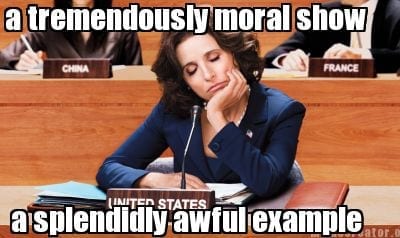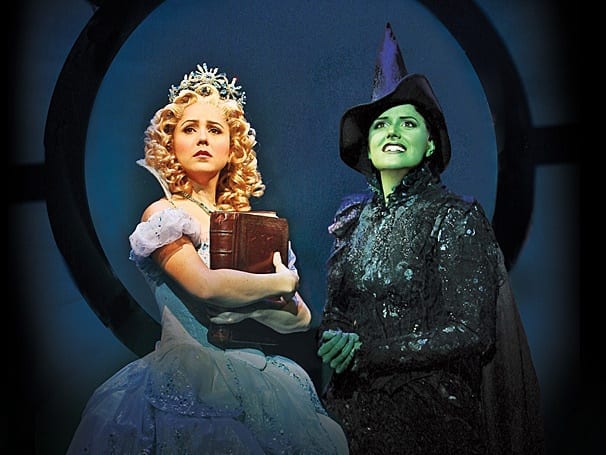Back when I was still a college professor, I used to teach a freshman level class in dramatic structure. I taught it for something like fifteen years. Loved that class. Loved working with freshmen, loved as well working with seniors who put off taking it until right before graduation. (You know who you are!) In that class, we taught real basic stuff, the various ways in which narratives can be structured. And we also taught a very rudimentary and simple sort of first-step dramatic criticism. I call it meatball criticism.
Here’s how it works. For most narratives we encounter in theatre and film (and also fiction, frankly), there’s a very basic structure most writers employ. Protagonist–objective–obstacle. There’s a character, the protagonist, whose choices and decisions drive the dramatic action. S/he has an objective, something s/he’s trying to accomplish. An obstacle prevents him/her from achieving it. Eventually, the protagonist either does or does not accomplish the objective.
In class, we read plays and we watched movies, and we tried to figure all this out—who the protagonist was, what s/he wanted, what prevented s/he from getting it. I always began the course by asking students to agree to two propositions that were not in fact true; that there was a single right answer to these questions, and that I, as professor, knew what that one right answer was. I was also very clear about the artificiality of those two premises. In fact, of course, there isn’t a right or wrong answer to structural questions, and I’m as likely to be wrong as anyone. But for pedagogical purposes, it made sense to start with the assumption that ‘who is the protagonist’ is a meaningful question, with a definite answer.
The protagonist is usually the main character, but that can be tough to determine. Who is ‘the main character’ in Butch Cassidy and the Sundance Kid, for example? What about a romantic comedy, like Sleepless in Seattle or While You Were Sleeping? When a story has two main characters, which of them is the protagonist? The answer is, the one who is more volitional. That is to say, the one who makes the biggest decisions in the story, the one whose choices drive the action. Butch Cassidy is the protagonist, not Sundance, of that film. I’d say the Meg Ryan character is the protagonist of Sleepless. After she hears Tom Hanks on the radio show, she’s the one who makes the biggest decisions in the story. And the Sandra Bullock character makes essentially all the decisions in While You Were Sleeping. I would suggest that Benedick pursues Beatrice a bit more than she pursues him in Much Ado About Nothing, and I would suggest that Viola makes the main choices in Twelfth Night.

“HAMLET’s easy: Hamlet’s the protagonist. STAR WARS is easy: Luke’s the protagonist.”
Hamlet’s easy: Hamlet’s the protagonist. Star Wars is easy: Luke’s the protagonist. But in those two stories, identifying the objective is trickier. What makes it tricky is that it’s easy to overthink these things. Hamlet’s objective is to figure out if the Ghost was telling the truth, and then act on it. Luke’s is to discover there’s such a thing as the Death Star, and then blow it up. Just remember, the objective isn’t ever something abstract: ‘she wants to be happy.’ It’s something concrete and specific: she wants to survive the Hunger Games.
Obstacles are similarly specific. Luke’s obstacle is, in part, that he hasn’t really learned how to use The Force effectively. But really, the main obstacle is just that it’s a really big Death Star. Katniss’ obstacle isn’t ‘her niceness.’ It’s ‘the other, better trained contestants.’ And then, also, secondarily, her niceness; her unwillingness to kill Peeta.
Over the course of a semester, students would see lots of films and read lots of plays, with an emphasis on plays and films where the protagonist wasn’t immediately apparent. And, of course, in really big, complicated narratives, there are multiple protagonists and objectives. In Game of Thrones, for example, a lot of characters have legitimate claims on the Iron Throne, and half the fun is rooting for and against the various claimants. This means multiple protagonists, though in fact really only one objective they basically all share. And a character that’s protagonist in one story-line might well be revealed as the antagonist in another character’s story. Every character in any story should have some objective, with meaningful obstacles strewn in his/her path. We want to identify the most important, but it’s also useful to recognize all the other protagonists who populate the tale.
So what’s meatball criticism? Well, simply stated, it’s criticism that builds directly and specifically on the protagonist/objective/obstacle structure. So let’s say that Luke is the protagonist of Star Wars, and that his objective is to blow up the Death Star, the main obstacle to which is the size and power of that Death Star. So one statement of meatball criticism would be ‘it is good to blow up Death Stars.’ But if we examine it a bit more, we can add this dimension—Luke can’t blow up the Death Star until he learns to trust the Force. So the meatball criticism statement would be ‘there exists a supernatural power in the universe that wants us to blow up Death Stars.’
Now, I’m not saying that this would be a terribly profound thematic statement or critical stance. In fact, it’s kinda dumb. Meatball criticism is frequently kinda dumb. That’s the point, in fact. It’s just a tool. It’s a means to an end. It’s a starting point.
But I really like it. I think there’s real value to it. Castaway, the Tom Hanks ‘deserted island’ film, could prompt this meatball criticism: ‘if you’re stranded on a desert island, you’ll do almost anything to get off.’ Well, duh. But then when you consider the loneliness and insularity and unwillingness to commit that defines the Tom Hanks character before and after the island episode, maybe something a little interesting might emerge.

“That’s a plausible meatball, and that’s also a horrible message for young women. But come on—it’s just GREASE.”
The weakness of meatball criticism is that it’s shallow. And it can lead to a kind of reductive moralism. In fact, you don’t have to have taken my class to practice meatball criticism, though you’d probably call it something else. Most reductive moralist criticism is basically just meatball. An example that I’m fond of is the 1978 film version of Grease. In Grease, the Olivia Newton-John character loves the John Travolta character. But he’s kind of a hood, and she’s a nice girl. Different worlds—it’s never going to work out. So she changes, pours herself into tight leather pants, smokes a cigarette, and sings “You’re the one that I want.” Meatball criticism: ‘it’s good to lower your personal standards to get the guy you like.’ That’s a plausible meatball, and that’s also a horrible message for young women. But come on—it’s just Grease. A fun little musical about various 1950’s cultural clichés. I would say that there’s some limited value in taking a moralistic meatball approach to that film, because it might inoculate young people against a negative message. But by all means, see the darn film. Just because you see a fun little flick about the ’50s doesn’t mean you’ll go around making major life decisions based on it.
In fact, there are a number of terrific films and plays that might strike us as immoral if we limit ourselves to meatball criticism. One of the main values of drama is the way it provides us with bad examples. There’s nothing wrong with films or plays in which terrible people get away with doing terrible things. I love the musical Dirty Rotten Scoundrels, for example.  I like it better than the film it’s based on. But there’s no denying that all the characters in that film are awful people. That’s essentially the definition of modern farce, for example. I’m very fond of the TV show Veep, for example. In Veep, Julia Louis-Dreyfuss plays the Vice-President of the United States, Selena Myers. Selena is grasping, selfish, ambitious, not terribly bright and not remotely moral. She’s in fact a terrible person. I would argue that it’s a tremendously moral show, by holding up for us such a splendidly awful example. Any genuine criticism of it would require, though, that we move well beyond meatball. (Read my full review of VEEP on MormonIconoclast.com)
I like it better than the film it’s based on. But there’s no denying that all the characters in that film are awful people. That’s essentially the definition of modern farce, for example. I’m very fond of the TV show Veep, for example. In Veep, Julia Louis-Dreyfuss plays the Vice-President of the United States, Selena Myers. Selena is grasping, selfish, ambitious, not terribly bright and not remotely moral. She’s in fact a terrible person. I would argue that it’s a tremendously moral show, by holding up for us such a splendidly awful example. Any genuine criticism of it would require, though, that we move well beyond meatball. (Read my full review of VEEP on MormonIconoclast.com)
Of course, a lot of big budget Hollywood movies are so structurally formulaic, the meatball criticism for any of them might be ‘heroes will always defeat bad guys.’ But even then, meatball’s a tool worth using. In the recent Superman movie, Man of Steel, for example, Superman’s objective isn’t really to save mankind. It’s more ‘decide if mankind is worth saving.’ And then, act accordingly. The Christopher Nolan The Dark Knight Rises, Batman’s objective is just straightforwardly ‘to defeat Bane.’ But what does Bane want? Examining that question can get very interesting.
I know that for some students, meatball criticism is too dumb to use. I get that. But I still use it in my own criticism, and consider it a terrifically helpful place to start when breaking down a play or a film. Just don’t end with that. Take it several steps deeper, look at what else might be going on. There’s value in starting with structure, and in a criticism based on structure. Just remember that every work of art is trying to do more than just tell a story. The structure is the means to an end, and the end, most of the time, is to say something, to communicate some truth about humanity. Meatball criticism is similarly a means to an end—to uncover that truth.





